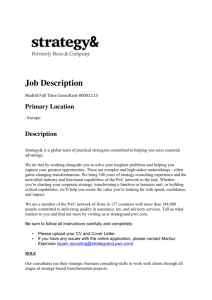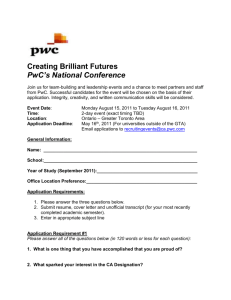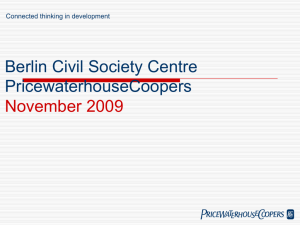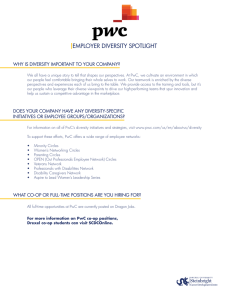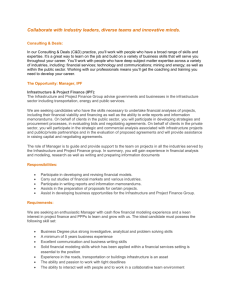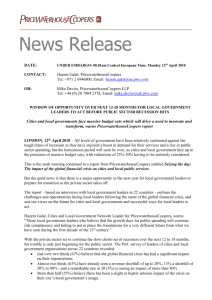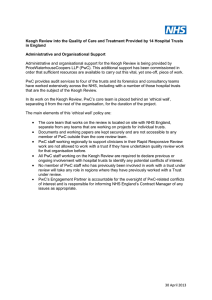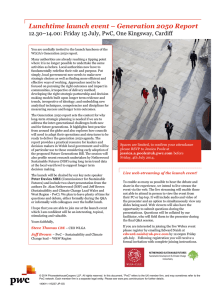The future of work A journey to 2022 10,000
advertisement
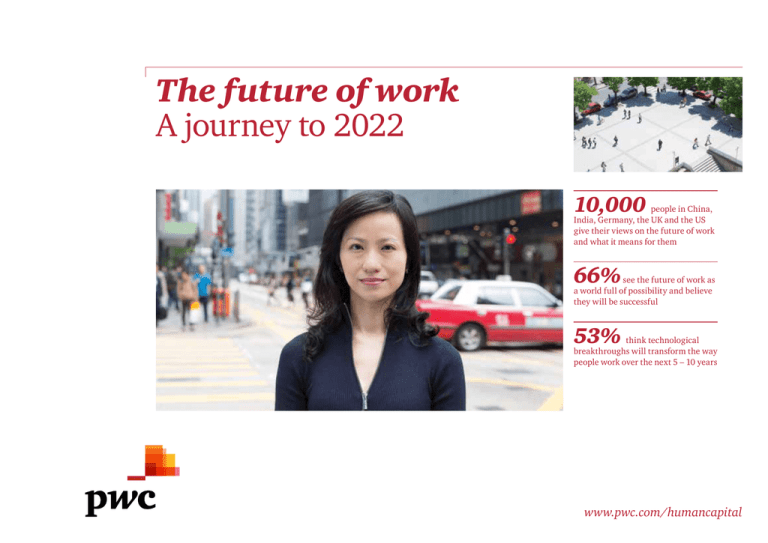
The future of work A journey to 2022 10,000 people in China, India, Germany, the UK and the US give their views on the future of work and what it means for them 66% see the future of work as a world full of possibility and believe they will be successful 53% think technological breakthroughs will transform the way people work over the next 5 – 10 years www.pwc.com/humancapital Contents A journey to 2022 2 Three worlds of work 4 The Blue World – corporate is king 10 The Green World – companies care 14 The Orange World – small is beautiful A summary of people management characteristics in 2022 Are you ready? 18 22 Appendix 26 Contacts 27 24 Foreword Disruptive innovations are creating new industries and business models, and destroying old ones. New technologies, data analytics and social networks are having a huge impact on how people communicate, collaborate and work. As generations collide, workforces become more diverse and people work longer; traditional career models may soon be a thing of the past. Many of the roles and job titles of tomorrow will be ones we’ve not even thought of yet. So how are these developments going to affect the talent your business needs? How can you attract, retain and motivate them? How is HR going to change as a result?’ The projections in this report build on the work started in 2007 by a team from PwC and the James Martin Institute for Science and Civilisation at the Said Business School in Oxford, who came together to develop a series of scenarios for the future of people management. The result was three ‘worlds of work’, which provide a lens through which to examine how organisations might operate in the future. In this report, we look to 2022 and consider how the characteristics of these three worlds of work are likely to be shaped by the changes coming up over the next eight years. This includes setting out the recruitment, reward and employee engagement strategies that are likely to be most relevant as these worlds evolve, and what this means for businesses, workforces and HR. This report draws on a specially commissioned survey of 10,000 people in China, India, Germany, the UK and the US, who told us how they think the workplace will evolve and how this will affect their employment prospects and future working lives. Further input comes from a survey of almost 500 HR professionals across the world, who share their insights on how they’re preparing for the changes ahead. Rohit Talwar, Global Futurist and the CEO of Fast Future Research, has also contributed his cutting-edge thinking to this study. Our thanks to all those who kindly shared their perspectives. No exploration of the future of work could ever be definitive. Indeed, one of the defining characteristics of our age is its ability to surprise and confound. However, while things happen that we cannot predict, we can still be prepared. Michael Rendell Head of Human Capital Consulting, PwC The future of work – A journey to 2022 1 A journey to 2022 2006 2007 2008 2009 2010 2011 2012 2013 Launch of Twitter Apple launches the iPhone Lehman Brothers files for bankruptcy Urban dwellers become a majority of the global population for the first time1 China overtakes the US as world’s largest manufacturer2 Global population passes 7 billion3 Impact of resource scarcity comes into sharp focus as prolonged droughts threaten blackouts in Texas (power plants are the largest users of water in the US)4 Number of mobile devices and connections surpasses the number of people on the planet5 1 Urban population growth, World Health Organisation (http://www.who.int/gho/urban_health/situation_trends/urban_population_growth_text/en/) 2 Economist, 10.03.12 3 Guardian, 31.10.11 4 Reuters, 30 April 2013 5 Cisco Visual Networking Index: Global Mobile Data Traffic Forecast Update, 2013–2018, Cisco, 05.02.14 2 PwC 2015 2016 2017 2018 2019 2020 2021 2022 Worker in Germany says the “best is yet to come” after celebrating 75 years’ service with the same firm $10 tablet computer comes on to the market Assembly workers in factory in Hanoi start wearing sensors to gauge concentration, work rate and mood Analysts attend presentation by Fortune 500 Chief Performance Officer, who heads a combined Finance and HR function Doctor in China carries out ‘remote’ surgery on patient in Ghana Rioting sweeps across university campuses as students lose patience with lack of job opportunities Licences granted for driverless cars World’s first fully automated and robot-served hotel opens The future of work – A journey to 2022 3 Three worlds of work Our scenario analysis sees the expectations of organisations and the aspirations of the people who want to work for them diverging into three distinct ‘worlds’ of work: Blue, Green and Orange. Blue World 4 PwC Green World A major shift in management practices to accommodate a rapidly changing world of work and the information workers that inhabit this world [will have the single biggest impact on the way we work over the next 10 years] Head of Talent, Information Technology Sector, South Africa Orange World The future of work – A journey to 2022 5 Three worlds of work At the beginning of the century, Ray Kurzweil, Futurist and Chief Engineer at Google, predicted that 20,000 years of progress would be crammed into the next 100.1 If anything, progress and change have accelerated even faster than that. Tremendous forces are radically reshaping the world of work. Economic shifts are redistributing power, wealth, competition and opportunity around the globe. Disruptive innovations, radical thinking, new business models and resource scarcity are impacting every sector. Businesses across the world are beginning to understand that they need a clear and meaningful purpose, and mandate for the decade ahead if they are to attract and retain employees, customers and partners. Figure 1 sets out the trends people around the world believe will transform the way people work over the next 5 – 10 years. It is important to reflect that the scale of expected change is not unprecedented. However, what is unique is the pervasive nature of the change and its accelerating pace. Figure 1: What will transform the way people work over the next 5 – 10 years? 53% 39% 36% 33% 26% 4% 13% Technology breakthroughs Resource scarcity and climate change Shifts in global economic power Demographic shifts Rapid urbanisation None of these Don’t know/not sure PwC survey of 10,000 members of the general population based in China, Germany, India, the UK and the US Managing complexity as well as ambiguity [will have the single biggest impact on the way we work over the next 10 years] Head of HR. Energy, Utilities and Mining, India 1 The Law of Accelerating Returns, Ray Kurzweil, 07.03.01 (http://www.kurzweilai.net/the-law-of-accelerating-returns) 6 PwC Competing forces What cuts across these developments are the push and pull of individualism versus collectivism and corporate integration versus business fragmentation. The competition between these forces is creating what we’ve identified as three scenarios (‘worlds’) for the future of work: • Large corporates turning into ministates and taking on a prominent role in society. • Specialisation creating the rise of collaborative networks. • The social and environmental agenda forcing fundamental changes to business strategy. Most organisations are likely to be a mix of all three worlds of work. As we explore in this report, it’s therefore useful to think about where your organisation might be positioned within these scenarios, the trade-offs this entails and what implications this has for your people management strategy. Evolving priorities The emergence of these three worlds is going to create fresh challenges for HR. Organisations currently grapple with the realities of skills shortages, managing people through change and creating an effective workforce. By 2022, the radical change in business models will mean that companies will be facing further issues such as: • The need to create ever more sophisticated people measurement techniques to monitor and control performance and productivity. • Increasing importance of social capital and relationships as the drivers of business success. • The boundary between work and personal life disappearing as companies assume greater responsibility for the social welfare of their employees. Changing role of HR HR has been perceived by many as a passive, service-oriented function. But given the demands of tomorrow’s workplace and business environment, we believe HR is at a crossroads and will go one of three ways: • With a proactive mindset and focused on business strategy, HR will take on a new wider people remit incorporating and influencing many other aspects of the business. • The function will become the driver of the corporate social responsibility agenda within the organisation. • The function will be seen as transactional and almost entirely outsourced. Organisations will have to be prepared to undergo new learning cycles and adapt themselves to these new challenges, not only to survive, but to succeed. Head of HR, Healthcare, India In the coming sections of this report, we explore the nature of these three worlds, what’s shaping them and how this will affect HR priorities, organisational design and wider business strategies. The future of work – A journey to 2022 7 Three worlds of work Fragmentation The Orange World Small is beautiful ompanies begin C to break down into collaboration networks of smaller organisations; specialisation dominates the world economy Collectivism 8 PwC Companies care Corporate is king Social responsibility dominates the corporate agenda with concerns about changes in climate and demographics, and embedding sustainability becoming the key drivers of business Big company capitalism rules as organisations continue to grow bigger and individual preferences trump beliefs about social responsibility The Blue World Integration The Green World Individualism There will be a major shift away from the thinking that we learn one profession, have one job and stay in it for decades. Female, voluntary worker (aged 33 – 47), Germany. The future of work – A journey to 2022 9 The Blue World – corporate is king Where big company capitalism reigns supreme The globalisers take centre stage, consumer preferences dominate, a corporate career separates the haves from the have-nots. 10 PwC Driving goal How to compete Profit, growth and market leadership. Scale is the crucial differentiator. It allows these mega-corporations to reach out across the globe and compete for talent and resources – constantly innovating and keeping pace with customer demands. Employee value proposition (the ‘deal’) Job security and long-term service with an organisation in return for employee commitment and flexibility. Relentless pressure to perform In the Blue World, big company capitalism reigns supreme. Consumer preferences and profit margins dominate in a model built around flexibility, efficiency and speed to market. The relentless pressure on performance isn’t just driven by competition from peers, but also aggressive new entrants looking to lead innovation and undercut existing players. Blue firms follow the money and go wherever the opportunity is – their operating model enables them to survive and thrive in both stable and volatile economic conditions alike. The challenges include how to integrate talent from different markets into the overall corporate culture. The need to lead innovation and open up new opportunities will also see them investing heavily in R&D and acquiring smaller start-ups. The attractions include high rewards for high-flyers. This is a chance to be one of the ‘haves’ in a world where stable employment is less and less the norm. Employees also have access to the pensions, health and other benefits that their host societies may not provide or be scaling back. Metrics and data are used to drive business performance through complex staff segmentation strategies which identify thousands of skills sets – creating precision around sourcing the right candidates for the right tasks, as well as on-the-job performance measurement and assessment. How to cater for flexibility with the right amount of trust and technological support to still exceed the expectations of clients [will have the single biggest impact on the way we work over the next ten years] 44 % 64 % The most important thing in a job for 44% of people around the world is job security. of people around the world believe that technology will improve their job prospects. PwC survey of 10,000 members of the general population based in China, Germany, India, the UK and the US Human Resource Director, Business Services, Kenya The future of work – A journey to 2022 11 The Blue World of 2022 People policies seek to lock in talent, but the top talent is still hard to attract and retain; many senior executives use personal agents to seek out the best deals. The data profiling that drives customer management will increasingly be replicated among employees as screening and monitoring move to a new level. Sensors check their location, performance and health. The monitoring may even stretch into their private lives in an extension of today’s drug tests. Periodic health screening gives way to real-time monitoring of health, with proactive health guidance and treatment to enable staff to perform more efficiently, reduce sick leave and work for more years before needing to retire. Blue firms have a network of relationships with third-party research centres, innovation firms and universities through which they fund and source new product and process ideas. They use mechanisms such as idea sourcing platforms, challenge contests and seeding of venture funds and incubators to bring a constant flow of opportunity. While some of the ideas make it into core products and processes, many are sold on or licensed to create a selffunding innovation model. Leadership teams have a high focus on the evolution of the corporate culture, with rigorous recruitment processes to ensure new employees fit the corporate ideal. New staff are subject to compulsory corporate culture learning and development programmes. The ‘contract’ with employees is defined by the handing over of data (e.g. health, performance, possibly even private life) in return for job security. More than 30% of the participants in our global survey would be happy for their employers to have access to their personal data. Younger people tend to be more open to this than older generations, so this kind of monitoring could become routine in the years to come. The speed of technological progress, such as the popularity of the ‘Internet of Things’, will have a big impact on the way we work over the next ten years. Male, in permanent employment (aged 33 – 47), China 3 out of 10 of the participants in our global survey would be happy for their employers to have access to their personal data. 12 PwC 31 % of HR professionals are gearing their talent strategies to pushing back the borders of innovation and possibility, employing only the best and offering long-term job security and reward. PwC survey of 480 HR professionals from across the world Changing organisational and HR demands The management of people within the Blue World is a hard business discipline, akin to finance within this scenario. In addition to identifying and delivering the talent needed to meet business objectives, successful HR teams are developing the ever more sophisticated measurement and management techniques needed to ensure that the workforce meets exacting performance targets. The HR function evolves into a people and performance unit, which is led by the Chief People Officer (CPO), who is a powerful and influential figure within the leadership team of the organisation. Those responsible for people management increasingly need financial, analytical, marketing and risk management skills to measure the impact of human talent on their organisation and retain the best people. Talent is managed alongside artificial intelligence in a hybrid model. HR will develop real-time response to data feeds as it evolves into a key part of the wider performance team. Reward models include a strong performance-related element. A key challenge for HR is convincing employees that the ‘price’ of data release and close monitoring is worth paying. This includes developing the right balance between the benefits (e.g. job security or health protection) and productivity gains of this personal data. It also includes building trust through codes of conduct about how data is acquired, used and shared. The machine will become fully intelligent and have the ability to think independently. Male, in permanent employment (aged 48 – 66), UK ? Questions for HR How can you develop the more sophisticated human capital metrics needed to constantly improve performance? How do you develop a broader resource optimisation approach in which machines, artificial intelligence and human beings work side by side? Where is the line between performance monitoring and personal space and how can you make sure the organisation stays within it? The future of work – A journey to 2022 13 The Green World – companies care Where consumers and employees force change Companies develop a powerful social conscience and green sense of responsibility. Consumers demand ethics and environmental credentials as a top priority. Society and business see their agendas align. 14 PwC Driving goal How to compete Positive social and environmental impact. A social and environmental conscience is demanded by customers and staff right through the organisation and its supply chain. The organisation must get it right in order to survive and compete. Employee value proposition (the ‘deal’) Ethical values and work – life balance in return for loyalty towards an organisation that does right by its employees. Rethinking values and goals In the Green World, companies take the lead in developing a strong social conscience and sense of environmental responsibility. They are open, trusting, collaborative learning organisations and see themselves playing an important role in supporting and developing their employees and local communities. Companies have strong control over their supplier networks to ensure that corporate ethical values are upheld across the supply chain, and are able to troubleshoot when things go wrong. In turn, the combination of ethical values, support for the real economy and familyfriendly hours is an opportunity to create a new employee value proposition that isn’t solely reliant on pay. Brands can rise and fall on the basis of their environmental and social impact, with government imposed corporate fines for bad behaviour in this highly regulated world. Corporate responsibility is not an altruistic nice to have, but a business imperative. Companies want to spend their profits to make a positive difference, but it’s become more important to make their profit in a responsible way. Employees are expected to uphold corporate values and targets around the green agenda. The need to travel to meet clients and colleagues is replaced with technological solutions, which reduce the need for faceto-face contact. Employees’ carbon footprint is carefully monitored and built into performance targets. As society gravitates towards more sustainable living, the HR function is forced to embrace sustainability and corporate responsibility as part of its people engagement and talent management agendas. Changing social and ethical values may put more pressure on employers to take a responsible attitude to looking after their employees’ health and wellbeing. In turn employees demand healthier workplaces and workplace behaviours. 65 % 36 % of people around the world want to work for an organisation with a powerful social conscience.1 of HR professionals are building their talent strategies around their organisations’ social and environmental conscience, which is intrinsic to the brand and matches the values and beliefs of their people.2 1 PwC survey of 10,000 members of the general population based in China, Germany, India, the UK and the US 2 PwC survey of 480 HR professionals from across the world The future of work – A journey to 2022 15 The Green World of 2022 Moves towards the Green World are being bolstered by the need to use resources in smarter and more efficient ways. The disillusionment that has followed in the wake of the financial crisis and public anger over some corporations’ environmental, social and tax policies is forcing ever more companies and workers to question the very nature and purpose of their business. Companies recognise they have more of an impact beyond their financial one so they now quantify their total impact on society, the environment, the economy and tax. Financial performance is in this mix, but it’s no longer the prime driver of decision making. Customers look to Green firms to introduce innovative ideas and practices and influence their own behaviour – often setting challenges around ways of working which can be transferred back into the customer’s own environment. Customers are proud to support Green firms and the broader societal goals they are pursuing. Technology and the internet play a critical role in providing total transparency of the firm’s environmental, social and ethical impact and performance across all of its activities. A distinctive feature of Green firms is the practice of co-creation – engaging with customers, partners, external agents and the local community to create new products 16 PwC and services that benefit the customer, the company and the broader community Diversity and work – life balance are viewed as sources of strength and competitive advantage. Staff are encouraged to forge links with the community and to take part in socially useful projects. Rather than basic performance, the emphasis is on using data to promote broader objectives, such as health and wellbeing, professional development, flexible working and volunteering. The development of environmental best practice is a key objective for employees, who are encouraged to create new and interactive ways to share ideas and encourage people to take them up. Changing organisational and HR demands The CEO drives the people strategy for the organisation, believing that the people in the organisation and their behaviours and role in society have a direct link to the organisation’s success or failure. Green firm pioneers avoid hierarchy and opt for flexible, flat and fluid organisational structures. Everyone in a Green firm has the opportunity to participate in decisionmaking and feels responsibility for the organisation’s success. HR and corporate social responsibility fuse and organisations embrace sustainability and support for socially valuable ‘good growth’. HR helps to foster close collaboration between employer and employee in designing jobs around aspirations and lifestyles. Reward models will be highly flexible as part of this personalised design. While our survey confirms that the opportunity to work for organisations that share their values and beliefs is attractive to many of the best and brightest candidates, the overall incentive package is still going to be important. Financial rewards can be augmented by the chance to take up secondments on social and environmental projects. Further challenges include how to ensure that strict compliance with laws and standards doesn’t inhibit flexibility and enterprise. In a caring organisation, there is also the question of how to keep people in employment if there is a downturn in the market or wider economy. Working closely with employees and other stakeholders, HR will be expected to come up with innovative solutions to these challenges. ? Questions for HR How can you turn your values into a compelling element of your employer brand? Is your function set up to work with people who want a greater say in designing their working responsibilities and rewards? How can you monitor the desired ethics and behaviour most effectively? Organisations in the Green World will embrace and embed Sustainability, understand and manage their total impact, and drive opportunities that reflect good growth ie. growth that’s responsible, real, lasting and inclusive. The need for economic and environmental efficiency [will have the single biggest impact on the way we work over the next ten years] Male, self-employed (aged 48 – 66), UK Crowded urban centres will necessitate ‘anywhere working’ aided by technology. VP Human Resources, Financial Services, USA Greater emphasis on work – life balance – more employees wanting work that fits around their life rather than focusing on a specific career path [will have the single biggest impact on the way we work over the next ten years] Human Resources Manager, Engineering and Construction, Australia The future of work – A journey to 2022 17 The Orange World – small is beautiful Where big is bad, for business, for people and for the environment Global businesses fragment. Technology empowers a low impact, high-tech business model. Networks prosper while large companies decline. 18 PwC Driving goal How to compete Maximising flexibility while minimising fixed costs. Embracing the rise of the portfolio career, hiring a diverse mix of people on an affordable, ad hoc basis. Employee value proposition (the ‘deal’) Flexibility, autonomy and varied challenges in return for working on a short-term contractual basis. 29 % Seeking out fresh opportunities In the Orange World organisations fragment into looser networks of autonomous, often specialised operations. Technology helps to bring these networks together, often on a task-by-task basis, with social media heightening the connectivity upon which this world depends. Supply chains are built from complex, organic associations of specialist providers, varying greatly from region to region and market to market. Looser, less tightly regulated clusters of companies are seen to work more effectively than their larger and potentially more unwieldy counterparts. Moves towards the Orange World have been bolstered by the rise of the portfolio career. Many people have come to realise that they could enjoy more flexibility and varied challenges by working freelance or as a contractor for a number of organisations. The Orange World desire for autonomy is strongest in China, especially among young people, indicating a generational shift towards greater freedom, entrepreneurship and specialist skills in this rapidly evolving economy. Over half of participants in China believe that traditional employment won’t be around in the future. Instead, people will have their own ‘brands’ and sell their skills to those who need them. The belief that the future lies in a contingent model is also strong among graduates, though people with fewer qualifications anticipate much less change in their working arrangements. 46 % The chance to take control of their career, what they do and when is what 29% of people around the world most want from a job.1 of HR professionals expect at least 20% of their workforce to be made up of contractors or temporary workers by 2022.2 1 PwC survey of 10,000 members of the general population based in China, Germany, India, the UK and the US 2 PwC survey of 480 HR professionals from across the world Contract employment will be king. Full-time jobs will become obsolete. Male, retired (aged 48 – 66), US People’s increasing need for diversified careers, mobility and flexibility [will have the single biggest impact on the way we work over the next ten years] Human Resources Manager, Asset Management, South Africa The future of work – A journey to 2022 19 The Orange World of 2022 Big business will be outflanked by a vibrant, innovative and entrepreneurial middle market. A core team embodies the philosophy and values of the company. The rest come in and out on a project-by-project basis. Some firms compete on quality and specialisation, while others offer commoditised price-dependent support. Telepresence and virtual solutions allow for greater remote working and extended global networks. Efficient systems and processes are the key to success of Orange companies. Maximum operational flexibility, lean staffing models, collaborative partnerships and minimal fixed costs are critical enablers of Orange firms. These companies make extensive use of technology to run their businesses, coordinate a largely external workforce and support their relationships with third parties. They take advantage of disruptive technology when appropriate and stay abreast of new developments to ensure they are up to speed in their sector. The development of networks and relationships with contingent staff is critical. Technology tracks their applicability, location and availability. 20 PwC Changing organisational and HR demands HR manages bidding processes as part of an open market for assignments in which people from within and outside the organisation apply and compete for postings and projects. Recruitment becomes largely a sourcing function, which is often merged with the management of the huge number of contracts and price agreements required for each company’s network of partner organisations. Many companies will be too small to have HR hiring teams and will look to technology or dedicated agents to supply needs. People are more likely to see themselves as members of a particular skill or professional network than as an employee of a particular company. Orange pioneers will give a new lease of life to professional guilds, associations and trade bodies – relying on them for training, development and innovation. Workers are categorised and rewarded for having specialist expertise, which will create increased demand for people to have a personal stake in the organisation’s or project’s success. Options such as project delivery-related bonuses are therefore going to become more common. A key challenge is ensuring that the people being hired genuinely have the expertise required or claimed. This demands a combination of effective verification and watertight contractual agreements, possibly with penalties for poor and non-delivery. It’s also going to require a high degree of relationship building and business trust. Many contractors and partners will adopt ‘eBay-style’ ratings of past performance to help land the next contract. ? Questions for HR How can you identify and attract the contract staff needed to meet different objectives? How can you verify the authenticity of the data being used to select staff and associates? How do you effectively manage nonowned resource? 2 out of 5 People around the world believe that traditional employment won’t be around in the future. Instead, people will have their own ‘brands’ and sell their skills to those who need them.1 31 % of HR professionals are building their talent strategies around the rise of the portfolio career, hiring a diverse mix of people on an affordable, ad hoc basis.2 1 PwC survey of 10,000 members of the general population based in China, Germany, India, the UK and the US Managing a diverse, heavily matrixed and virtual organisation [will have the single biggest impact on the way we work over the next ten years] 2 PwC survey of 480 HR professionals from across the world Vice-President for Human Resources, Retail and Consumer, Switzerland The future of work – A journey to 2022 21 A summary of people management characteristics in 2022 Corporate is king: Blue World How organisations source and attract talent Organisations compete to find and secure the best talent available and use extensive search and evaluation methods to find the stars of tomorrow. Talent is attracted by the potential for high earnings, job security and status. Companies care: Green World Green World companies seek likeminded individuals to extend their corporate family, taking great care to only select talent with the right behaviours and attitudes. Small is beautiful: Orange World Technology provides the solution to finding and evaluating contractors as suppliers of key skills. Commercial terms are offered for a specific task. Talent is attracted to Green World brands, their values and their culture. A company’s reputation within networks and online recruitment markets is crucial in attracting talent. Reward and performance Reward is based on finely tuned performance metrics. Organisations focus on total reward, which recognises corporate citizenship and good behaviours alongside performance. Contract-based pay for projects is the norm. Results-based or buy-in contracts are also common. Negotiation skills are vital. Learning and development's role Individuals build skills and experience to adapt to changing business needs. Learning and development is closely aligned to objectives and performance measures. Personal and professional development fuse in areas such as volunteering. Individuals develop their own skills. Professional guilds will re-emerge and certify skills alongside online references and performance rankings. The role of HR HR uses advanced analytics to predict future talent demands and to measure and anticipate performance and retention issues. HR acts as guardian of the brand. There is a strong focus on creating the right culture and behaviours and on guarding against sustainability and reputational risk across the supply chain. HR focuses on sourcing contractors and negotiating the contracts, along with performance management and project economics. Role of technology in managing people Sensors and data analytics to measure and optimise performance. Helping people to build work into their lives and minimise their environmental impact. Creating virtual collaboration. 22 PwC The future of work – A journey to 2022 23 Are you ready? The effectiveness with which your organisation plans people management for the long-term will be critical to its long-term viability, ensuring you have the right people, with the right skills, in the right places to realise your evolving goals. Think too much in the short-term and you may find yourself on the back foot, unable to catch up with sudden shifts in your marketplace. Forward-looking HR teams are already considering a range of different scenarios for the future as part of their business planning (see Figure 2), but few are taking a sufficiently longer term view to deal with them. Most of the HR professionals in our survey don’t believe they’re prepared for meeting the needs of a workforce that demands more freedom, autonomy and flexibility. Only around 20% report that they’re ready to embrace the role of technology and automation in replacing knowledge workers, even though most recognise this is something they should consider. Figure 2: Planning ahead – How far does HR in your organisation look into the future? 21% 56% Medium-term: Short-term: I anticipate a lot of change and am building possible future scenarios into our current talent pipelines The future is moving so fast that it is very hard to predict how things will change 24% Long-term: I am actively considering the evolving and multiple visions of the future as part of our long-term business planning 24 PwC PwC survey of 480 HR Professionals from across the world. As Figure 3 outlines, our three worlds can provide a starting point for judging the opportunities, risks and evolving demands on HR across different areas of your organisation. But no one model will prevail and even within them, it will be important to manage competing demands. Figure 3: How can organisations plan for the future of people management? Which world are you heading towards: Blue, Green, Orange or something else entirely? What are the scenarios for your organisation? How will your organisation’s culture respond to an environment of constant change? What will be the role of leadership? What behaviours will be most valuable to the organisation and how will the organisation need to communicate with and engage all employees? What do you need to do to get there? Better understand where you are now through use of evaluation techniques, benchmarking and measurement. How will your organisation need to change...resourcing, talent management, employee engagement, reward, learning and development... what else? The future of work – A journey to 2022 25 So what does the future hold for HR? In the Blue World, it will be at the centre of a hugely influential metric-driven strategy and performance function. In the Orange World, it is set to have a much narrower recruitment and tendering role, with many other aspects of the function outsourced. In the Green World, HR’s role could be much more diffuse, helping employees to shape their work around their values and outside lives. Whatever path your function follows, it’s going to look very different in 2022. 26 PwC Blue World Green World Orange World The future of work – A journey to 2022 27 Appendix iness fragmentation Bus Collectivism e sm ol r on Gl ob al is l eg rs ve Re barriers to free movement of people and goods lt ro t on Ic Cor p o r a te i n t e g r a t i o n BIg business rules all PwC Focus on individual wants; a response to the infinite choices available to consumers ec hn ol og y Global forces ob al isa tio Protectionist policies begin to rebuild n 28 The free-market trend prevails as trade barriers disappear Individualism We started our research by examining the forces that were affecting global business and were likely to have significant impact on the future. While there are many social, The common good prevails over environmental, religious and demographic personal preference, e.g. collective factors that have a significant influence, responsibility for the environment we chose to focus on the global forces over individual interest that we feel have the greatest impact on people management. Tec hn ol og yc Allowing technology into almost every part of a person’s life n io at Creating the three worlds We worked with the James Martin Institute to think about the factors that were affecting business and those that we believed would grow in importance in the future. We mapped these around a matrix and developed a number of scenarios: plausible futures around each. The potential break-up of large businesses and the risk of collaboration networks A yearning for the human touch minimises the personal impact of technology on consumers Contacts Michael Rendell Human capital consulting Global Network Leader +44 20 7212 4945 michael.g.rendell@uk.pwc.com Justine Brown Global marketing & business development, Human resources services +44 113 289 4423 justine.brown@uk.pwc.com North America Central & Eastern Europe India Scott Olsen +1 646 471 0651 scott.n.olsen@us.pwc.com Zsolt Szelecki +44 20 7804 1710 szelecki.zsolt@uk.pwc.com Padmaja Alaganandan +91 80 4079 4001 padmaja.alaganandan@in.pwc.com Bhushan Sethi +1 646 471 2377 bhushan.sethi@us.pwc.com Middle East Australia David Suarez +971 4304 3981 david.suarez@ae.pwc.com Jon Williams +61 (2) 8266 2402 jon.williams@au.pwc.com China/Hong Kong South and Central America Mandy Kwok +852 2289 3900 mandy.kwok@hk.pwc.com Joao Lins +55 11 3674 3536 joao.lins@br.pwc.com Lukia Xing +86 (10) 6533 7018 lukia.xing@cn.pwc.com Africa Western Europe Jon Andrews +44 20 7804 9000 jon.andrews@uk.pwc.com Peter De Bley +32 2 7104321 peter.de.bley@be.pwc.com Charles Donkor +41 58 792 4554 charles.donkor@ch.pwc.com Till Lohmann +49 40 6378-8835 till.r.lohmann@de.pwc.com Singapore Gerald Seegers +27 (11) 797 4560 gerald.seegers@za.pwc.com Alywin Teh +65 62367268 alywin.teh@sg.pwc.com The future of work – A journey to 2022 29 www.pwc.com/humancapital PwC helps organisations and individuals create the value they’re looking for. We’re a network of firms in 157 countries with more than 184,000 people who are committed to delivering quality in assurance, tax and advisory services. Tell us what matters to you and find out more by visiting us at www.pwc.com. This publication has been prepared for general guidance on matters of interest only, and does not constitute professional advice. You should not act upon the information contained in this publication without obtaining specific professional advice. No representation or warranty (express or implied) is given as to the accuracy or completeness of the information contained in this publication, and, to the extent permitted by law, PwC does not accept or assume any liability, responsibility or duty of care for any consequences of you or anyone else acting, or refraining to act, in reliance on the information contained in this publication or for any decision based on it. © 2014 PwC. All rights reserved. PwC refers to the PwC network and/or one or more of its member firms, each of which is a separate legal entity. Please see www.pwc.com/structure for further details. Design Services 28665 (05/14).
